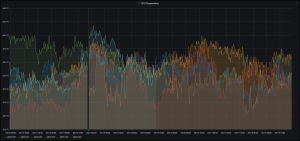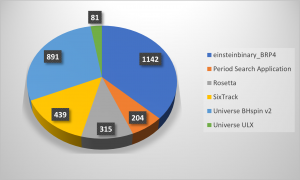As today the Raspberry Kubernetes Cluster consists of 4 Raspberry Pi 4 (8GB RAM) and runs on Raspberry Pi OS (64 Bit) beta. The Cluster is build with Rancher K3S. Each BOINC pod has assigned 3 CPUs and 6GB of RAM. The container runs BOINC-client Version 7.16.11. The BOINC Cluster is volunteering for Rosetta@Home, Einstein@Home, LHC@Home and Universe@Home. Computing preferences for all Projects are identical (use 100% of available CPUs, 90% of available CPU Time, 100% of available RAM). Resource Share for the Projects are: Rosetta@Home 35%, Einstein@Home 35%, LHC@Home 25%, Universe@Home 5%. Universe@Home seems to supports ARM Platforms but does not yet supply tasks to 64bit AARM OS.
I summarized the finished tasks from 22.01.2021 to 29.01.2021. Aborted tasks or tasks with runtime 0:00 have been removed from this analysis. Statistics have been collected with BoincTasks and summarized in Excel. Results:
| Project | Application | Tasks done | Avg (h) | Min (h) | Max (h) |
| Einstein@Home | 0.11 einsteinbinary_BRP4 | 371 | 2,18 | 1,19 | 2,59 |
| Rosetta@Home | 4.20 Rosetta | 102 | 7,92 | 4,29 | 8,56 |
| LHC@Home | 502.05 SixTrack | 65 | 10,14 | 0,01 | 13,98 |
With this numbers as reference, we can start to optimize the throughput of the BOINC cluster.
When we consult Grafana Cluster stats I should mention than RAM consumption was always below 4 GB in this period. Since the current setup assigns 3 CPU to the pod on each node, only 3 tasks are computed in parallel which reduces the amount of used ram. Einstein@Home and LHC@Home are quite thrifty and allocating only ~200 MB max per task. Rosetta@Home is more thirsty and has allocated some tasks with ~1.4 GB while crunching.

So if you are happy with that throughput you may be able to build a cheaper cluster based on Raspberry Pi 4 Models with 4 GB of RAM each. As long as you volunteer only for LHC@Home and Einstein@Home, a 4 GB model might also do the job with 4 parallel tasks. On the other hand, the 8 GB model is relatively new to the market. It might be that tasks for ARM based computers are carved especially for this breed. It may change in the future.
Next Benchmark will be with 4 CPU per pod and adjusted computing preferences.


